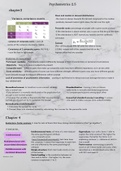Summary
2.5 Psychometrics: Condensed summary of everything you need to know for the exam chapters 3-11
- Course
- Institution
A complete summary of chapters 3 through 11 including integrated information from the lectures (with pictures). Explains psychometrics in simple language and how to apply it. Includes everything that is relevant in just 8 pages, kept concise to save you time. Got an 8.4 on my exam with these. Enjoy!
[Show more]



